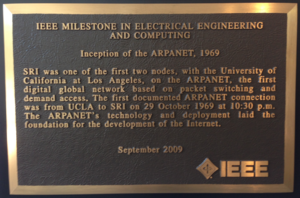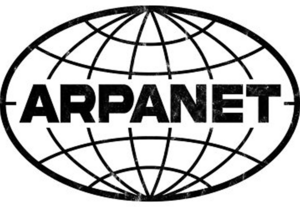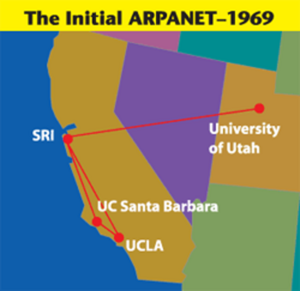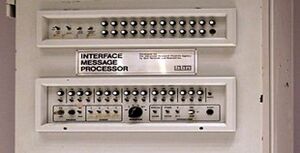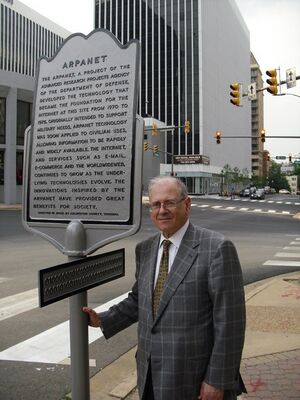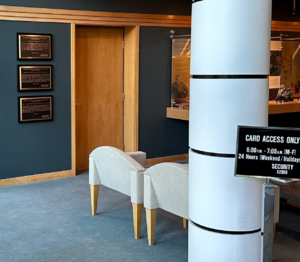Milestones:Inception of the ARPANET, 1969: Difference between revisions
No edit summary |
No edit summary |
||
| (15 intermediate revisions by 4 users not shown) | |||
| Line 1: | Line 1: | ||
{{Milestone box | |||
|Date Dedicated=2009/09/16 | |||
|Dedication=97 | |||
|Location=Menlo Park, California, U.S.A. | |||
|IEEE Regions=6 | |||
|IEEE sections=Santa Clara Valley | |||
|Summary=The "Brown Box" console, developed at Sanders Associates - later BAE Systems - between 1966 and 1968, was the first interactive video game system to use an ordinary home television set. This groundbreaking device and the production-engineered version Magnavox Odyssey game system (1972) spawned the commercialization of interactive console video games, which became a multi-billion dollar industry. | |||
|Abstract=SRI was one of the first two nodes, with the University of California at Los Angeles, on the ARPANET, the first digital global network based on packet switching and demand access. The first documented ARPANET connection was from UCLA to SRI on 29 October 1969 at 10:30 p.m. The ARPANET’s technology and deployment laid the foundation for the development of the Internet. | |||
|Special citation=No | |||
}} | |||
[[image:ARPANET-1969.png|thumb]] | |||
[[image:ARPANET-Logo.png|thumb|ARPANET logo]] | |||
The application of packet switching and demand access are fundamental differences between the INTERNET and previous circuit switching based networks. It utilizes network resources by dynamically sharing them among many streams. This leads to significantly improved efficiency and robustness of the network. The layering scheme it introduces has allowed the development of flexible protocols, as well as the efficient communication between different computing platforms. | [[image:Initial-ARPANET.png|thumb|The ARPANET's first 4 nodes]] | ||
[[image:IMP.jpg|thumb|Front panel of Interface Message Processor (IMP) used to interconnect ARPANET networks]] | |||
[[image:ARPANET-Historical-Marker-Kahn.jpg|thumb|TCP co-designer Robert Kahn and ARPANET historical marker, in front of the former Wilson Blvd. DARPA HQ building in Arlington, VA]] | |||
[[image:SRI-Lobby.png|thumb|3 SRI Milestone plaques in Visitors Lobby: Inception of the ARPANET, SHAKEY the Robot, and Engelbart's Public Demonstration]] | |||
''Inception of the ARPANET, 1969'' | |||
''SRI was one of the first two nodes, with the University of California at Los Angeles, on the ARPANET, the first digital global network based on packet switching and demand access. The first documented ARPANET connection was from UCLA to SRI on 29 October 1969 at 10:30 p.m. The ARPANET’s technology and deployment laid the foundation for the development of the Internet. '' | |||
'''This milestone's plaque can be seen in the Visitors Lobby of SRI International Building A, 333 Ravenswood Ave., Menlo Park, CA 94025 (GPS: 37.45758, -122.17642), which is open to the public 7am-6pm on weekdays. It is the 1st of 3 Milestone plaques mounted on the left wall.''' | |||
The dedication of this Milestone took place at the Computer History Museum in Mountain View, CA on September 16, 2009, with Internet Pioneer Vint Cerf amongst those officiating. This event also celebrated IEEE's 125th anniversary, one of eight such events held around the world that year. | |||
The deployment of the ARPANET set in motion a train of developments that led to the Internet as we know it today. The ARPANET was the first global packet-switching based network, and allowed remote network access to varied applications from multiple users among different computer platforms. It also applied the concept of protocol layering to communications. This development was the key to allowing a diverse set of users to operate over the telephone network of the day, which was optimized for voice and not suited to data traffic. With the introduction of a highly adaptive and robust technology for network access, the ARPANET formed the foundation of today’s Internet. | |||
The Internet is leading the way into a twenty-first century information society. It has penetrated our institutions and has changed our behavior and attitudes in fundamental ways. More than one billion people on this planet use the Internet today in daily life, in business, in government, and in academia all around the world. The younger generation cannot conceive of a time when they could not share their photos, chat with friends, stream video, or shop online. We can never turn the clock back to the pre-Internet world. | |||
The application of packet switching and demand access are fundamental differences between the INTERNET and previous circuit switching based networks. It utilizes network resources by dynamically sharing them among many streams. This leads to significantly improved efficiency and robustness of the network. The layering scheme it introduces has allowed the development of flexible protocols, as well as the efficient communication between different computing platforms. | |||
The ARPANET differed from previous computer networks (e.g. SAGE) in that those networks were specialized constructions, designed to link specific machines of a similar type together, whereas ARPANET was designed to allow machines to communicate efficiently irrespective of type. | The ARPANET differed from previous computer networks (e.g. SAGE) in that those networks were specialized constructions, designed to link specific machines of a similar type together, whereas ARPANET was designed to allow machines to communicate efficiently irrespective of type. | ||
List of supporting documents and publications submitted in electronic format: | |||
Shapiro, E., “A Study of Computer Network Design Parameters”, SRI Project 7016 Final Report, submitted to ARPA Dec 1968<br>Crocker, S., “Host Software”, IETF [http://tools.ietf.org/html/rfc1 RFC 1], April 1969<br>Duvall, B., “Host software”, IETF [http://tools.ietf.org/html/rfc2 RFC 2], April 1969 <br>Crocker, S., “Documentation Conventions”, IETF [http://tools.ietf.org/html/rfc3 RFC 3], April 1969 <br>Shapiro, E., “Network Timetable”, IETF [http://tools.ietf.org/html/rfc4 RFC 4], March 1969<br>Deloche, G., “Host-IMP Interface”, IETF [http://tools.ietf.org/html/rfc7 RFC 7], May 1969<br>Cerf, V., “IMP-IMP and Host-Host Control Links”, IETF [http://tools.ietf.org/html/rfc18 RFC 18], Sept 1969<br>Cerf, V., “Host-host Control Message Formats”, IETF [http://tools.ietf.org/html/rfc22 RFC 22], Oct 1969<br>English, B., “Time Standards”, IETF [http://tools.ietf.org/html/rfc28 RFC 28], Jan 1970<br>Melvin, J., “IMP-IMP Teletype Communication”, IETF [http://tools.ietf.org/html/rfc41 RFC 41], March 1970<br>Ancona, E.I., “Message Data Types”, IETF [http://tools.ietf.org/html/rfc42 RFC 42], March 1970<br>Westheimer E., “Status of Network Hosts”, IETF [http://tools.ietf.org/html/rfc287 RFC 287], Dec. 1971<br>Internet History, http://www.computerhistory.org/internet_history/<br>Kleinrock, L., “The Birth of Internet”, http://www.lk.cs.ucla.edu/LK/Inet/birth.html<br>Kleinrock, L., “Models for Computer Networks,” Conference Record, IEEE International Conference on Communications, Boulder, Colorado, pp.21-9 to 21-16, June 1969<br> | |||
{{Milestone|GeoLoc=37.459237, -122.174149|Description=Stanford Research Institute, Menlo Park, CA. SRI was one of the first two nodes, with the University of California at Los Angeles, on the ARPANET, the first digital global network based on packet switching and demand access. The first documented ARPANET connection was from UCLA to SRI on 29 October 1969 at 10:30 p.m. The ARPANET’s technology and deployment laid the foundation for the development of the Internet.}} | |||
[[Category:Internet|Arpanet]] [[Category:Computing and electronics|Arpanet]] | |||
Latest revision as of 19:18, 20 November 2023
- Date Dedicated
- 2009/09/16
- Dedication #
- 97
- Location
- Menlo Park, California, U.S.A.
- IEEE Regions
- 6
- IEEE sections
- Santa Clara Valley
- Achievement date range
- 1969
Inception of the ARPANET, 1969
SRI was one of the first two nodes, with the University of California at Los Angeles, on the ARPANET, the first digital global network based on packet switching and demand access. The first documented ARPANET connection was from UCLA to SRI on 29 October 1969 at 10:30 p.m. The ARPANET’s technology and deployment laid the foundation for the development of the Internet.
This milestone's plaque can be seen in the Visitors Lobby of SRI International Building A, 333 Ravenswood Ave., Menlo Park, CA 94025 (GPS: 37.45758, -122.17642), which is open to the public 7am-6pm on weekdays. It is the 1st of 3 Milestone plaques mounted on the left wall.
The dedication of this Milestone took place at the Computer History Museum in Mountain View, CA on September 16, 2009, with Internet Pioneer Vint Cerf amongst those officiating. This event also celebrated IEEE's 125th anniversary, one of eight such events held around the world that year.
The deployment of the ARPANET set in motion a train of developments that led to the Internet as we know it today. The ARPANET was the first global packet-switching based network, and allowed remote network access to varied applications from multiple users among different computer platforms. It also applied the concept of protocol layering to communications. This development was the key to allowing a diverse set of users to operate over the telephone network of the day, which was optimized for voice and not suited to data traffic. With the introduction of a highly adaptive and robust technology for network access, the ARPANET formed the foundation of today’s Internet.
The Internet is leading the way into a twenty-first century information society. It has penetrated our institutions and has changed our behavior and attitudes in fundamental ways. More than one billion people on this planet use the Internet today in daily life, in business, in government, and in academia all around the world. The younger generation cannot conceive of a time when they could not share their photos, chat with friends, stream video, or shop online. We can never turn the clock back to the pre-Internet world.
The application of packet switching and demand access are fundamental differences between the INTERNET and previous circuit switching based networks. It utilizes network resources by dynamically sharing them among many streams. This leads to significantly improved efficiency and robustness of the network. The layering scheme it introduces has allowed the development of flexible protocols, as well as the efficient communication between different computing platforms.
The ARPANET differed from previous computer networks (e.g. SAGE) in that those networks were specialized constructions, designed to link specific machines of a similar type together, whereas ARPANET was designed to allow machines to communicate efficiently irrespective of type.
List of supporting documents and publications submitted in electronic format:
Shapiro, E., “A Study of Computer Network Design Parameters”, SRI Project 7016 Final Report, submitted to ARPA Dec 1968
Crocker, S., “Host Software”, IETF RFC 1, April 1969
Duvall, B., “Host software”, IETF RFC 2, April 1969
Crocker, S., “Documentation Conventions”, IETF RFC 3, April 1969
Shapiro, E., “Network Timetable”, IETF RFC 4, March 1969
Deloche, G., “Host-IMP Interface”, IETF RFC 7, May 1969
Cerf, V., “IMP-IMP and Host-Host Control Links”, IETF RFC 18, Sept 1969
Cerf, V., “Host-host Control Message Formats”, IETF RFC 22, Oct 1969
English, B., “Time Standards”, IETF RFC 28, Jan 1970
Melvin, J., “IMP-IMP Teletype Communication”, IETF RFC 41, March 1970
Ancona, E.I., “Message Data Types”, IETF RFC 42, March 1970
Westheimer E., “Status of Network Hosts”, IETF RFC 287, Dec. 1971
Internet History, http://www.computerhistory.org/internet_history/
Kleinrock, L., “The Birth of Internet”, http://www.lk.cs.ucla.edu/LK/Inet/birth.html
Kleinrock, L., “Models for Computer Networks,” Conference Record, IEEE International Conference on Communications, Boulder, Colorado, pp.21-9 to 21-16, June 1969
